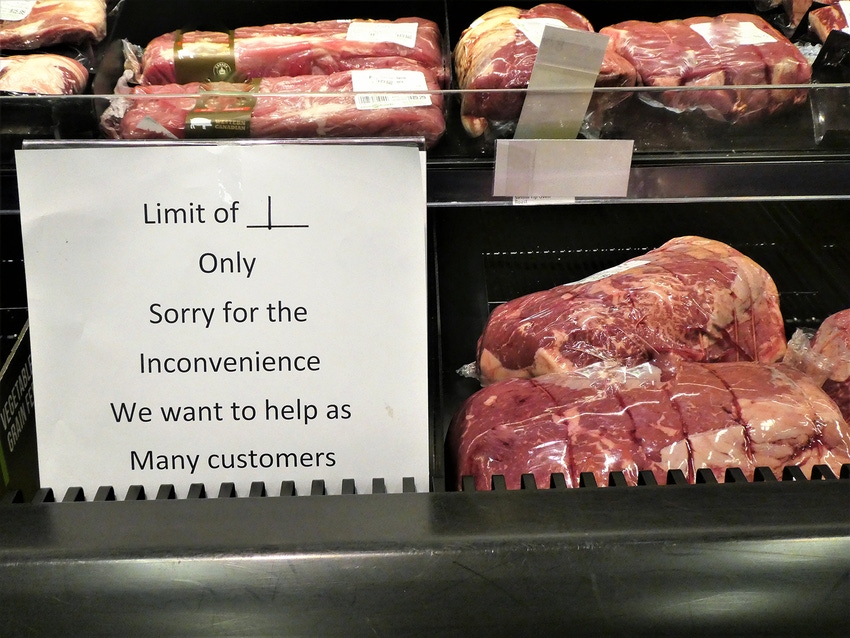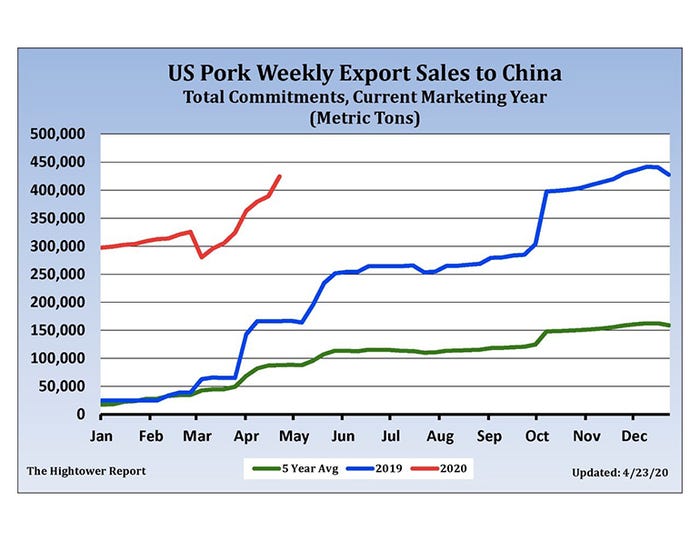Shelter in place followed by disaster
Last week, the kill was down 22% from the previous week and off 35% from the previous year. The industry backed up more than 1 million hogs last week alone.
May 4, 2020

There is about to be a severe meat shortage in America as unharvested animals are backed up, severely, at the farm. COVID-19 is disrupting the food chain and while causing inconvenience and sight hardship for some, it's causing sheer disaster at the farm level.
I've been discussing the impending labor problem facing packers for several months. My expectation was this would come to a head this fall when the capacity to kill hogs might be challenged by labor constraints to get the job done. Little did I know the labor issue would be front and center in a matter of weeks.
Federal and local health officials have had a hand in shutting down packing plants, citing the plants for being a hot bed for the virus. Really? The plants are not the hot bed but rather it's the inability for the employees to effectively shelter in place. This is an immigrant work force. My remarks are not intended to be disparaging at all. In fact, I admire greatly that fact these people are willing and eager to take jobs that very few Americans will accept. I admire their strong work ethic, strong family ties and the fact that many of them live as cheaply as possible so they can afford to send money back home to relatives. But it appears totally lost, especially on the local health officials, that fact that these employees are all living together, sometimes many families in a single dwelling, are unable to shelter in place. They're spreading the virus among themselves. Packing plants are not the hot beds for the virus, employee living conditions is.
Packers are taking extreme measures to protect their employees through new procedures in the plant, social distancing where possible, and eventually a full arsenal of personal protective equipment. While all of this will help protect the employee at the work place, they're still vulnerable when they return home each evening.
The shut down and dramatically reduced speed of processing for those plants not shut down has created a major crisis for hog producers (beef producers are caught up in the same mess). It started the first week of April when the weekly hog kill dropped 5% compared to the previous week. The following week the kill dropped another 6% compared to the week prior. So now we're starting to back up hogs in a fairly serious manner. The third week saw the kill decline 8% from the week prior, resulting in a weekly harvest running 6% lower than the previous year. The kill should have been up 4% from last year. Now the backlog is becoming very serious. Week No. 4 saw the decline in slaughter accelerate further, dropping by 12% from the previous week and now down a dramatic 15% from the previous year. At this point, it's becoming evident that we're now backing up more that 100,000 pigs per day. Finally, last week, the kill was down 22% from the previous week and off 35% from the previous year. The industry backed up more than 1 million hogs last week alone. Describing what's happening as a crisis is an understatement…catastrophe is more accurate.
In the wake of the virus spread, with the peak perhaps another two weeks down the road, pork packers will face an impending labor shortage. When all plants are running again, due to protective measures in place, all plants will be running at reduced chain speeds. Processing fewer animals each day means there's only one way to work through the serious backlog. Plants will have to run longer hours such as two shifts on Saturday's and Sunday's for an indefinite period. They can only do this with more labor. No one can be expected to work seven days a week. There is one other avenue to pursue. A program to put down the serious backlog (which some individual producers have already been forced to start) could effectively eliminate the problem. Such a program is going to be a tough sell to the pubic when there's meat shortages at retail.
Regardless, livestock producers need help and they need it fast. Airlines are getting government help, small businesses are getting forgivable loans, the unemployed are getting an extra $600 per week in benefits plus a $1,200 stimulus check. Where is the help for the livestock producers who are currently facing the biggest crisis of their lifetimes? Talk about food insecurity. If a large number of these producers leaves the business, 12 to 16 months from now Americans will know all about food insecurity.
The path of the futures market is extremely uncertain at this moment. Currently all lean hog futures are priced under the cost of production for all producers. Given the fact that some fairly large sow liquidation has begun, this tells me that the deferred contracts, say the Dec. 20 hogs and all of the 2021 hog contracts are grossly undervalued. In the next several weeks, the direction of the nearby contracts is a bit tougher to predict. Currently the sharp downturn in production is causing product values to explode upward and driving the value of the lean hog index higher. This index is heavily weighted with formula pricing which is tied to the value of the hog carcass. While the packing plants will soon start back up, although at first at reduced levels, hopefully in three to four weeks shelter in place will be lifted.
As the economy begins to open back up, one of the first things to occur will be the return of foodservice demand. Reduced production in the face of an increase in demand should drive the hog carcass even higher. The 2014 high in the carcass was $130. The current value of the carcass stands at $106.61 and it has more than doubled in a period of three weeks and two days. Indeed, in the very short term, look for the 2014 high in the carcass to possibly be challenged.
If by chance the plants start running and they're somehow able to run hard and fast, as huge margins are going to encourage them to do, it's also possible that the carcass will top and prices will come crashing downward until the backlog is worked through the system. Early in the crisis this is the outcome I expected. Now, as the crisis continues to worsen, I'm wondering if a severe break in prices may be completely avoided. A large scale "rescue" program, should one be enacted, would put down millions of fat hogs, effectively removing the product from the marketplace forever. It's possible this will occur whether a rescue problem is developed or not. Some producers simply may have no choice. The difference however, will be the number of producers still in business in the wake of this crisis.
If producers can somehow survive this awful situation, vastly better times lie ahead. In my opinion, we're looking at major lows in livestock prices that will be in place for years. Major lows.
Total pork exports and exports to China continue to thrive. This is "essential business" for the U.S. pork industry. Expansion over the last several years has been predicated upon ramped up exports which are just starting to develop nicely. So far this year the Chinese have booked as much pork as they did in all of last year. In addition, barring some rekindling of the trade war, Chinese U.S. pork imports should continue to increase under the terms of the phase one trade agreement. Please note the graph compliments of Hightower Research.

Source: Dennis Smith, who is solely responsible for the information provided, and wholly owns the information. Informa Business Media and all its subsidiaries are not responsible for any of the content contained in this information asset. The opinions of this writer are not necessarily those of Farm Progress/Informa.
About the Author(s)
You May Also Like





